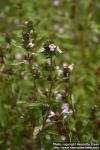2.33 Savory, summer and winter
 Latin name:
Latin name:
Summer savory: Satureja hortensis
Winter savory: Satureja montana
2.33.1 Growing savory
From: nmm1.cam.ac.uk (Nick Maclaren):
Summer Savory: This is a medium-sized (1') annual, and needs reasonably warm, damp conditions for germination, but needs only a little water thereafter. It has small seeds, so don't sow it too deep. It may be possible to sow it for succession in warmer climates than the UK, but it isn't here.
Winter Savory: Treat it exactly as common thyme (thymus vulgaris), which it closely resembles; however, it is slightly more compact, darker leaved and has white flowers. Like thyme, it makes a good edging plant.
From: Esther Czekalski <E.Czekalski.MA02Q.BULL.COM>
Summer savory is sometimes called the bean herb because it goes so well with green beans. It is a much more delicate plant than winter savory and in my experience, can handle a little more shade. In my zone I can only grow it as an annual; winter savory will overwinter and stay almost evergreen if it's mulched a bit.
2.33.2 Harvesting savory
From: nmm1.cam.ac.uk (Nick Maclaren):
Summer Savory: The leaves can be used fresh or dried in the usual way.
Winter Savory: The leaves can be used fresh or dried in the usual way, but it is evergreen in the UK (again, exactly like thyme).
2.33.3 Using / preserving savory
From: nmm1.cam.ac.uk (Nick Maclaren):
Winter Savory: It has a flavour somewhere between thyme and summer savory, but is slightly bitter. It can be used as an alternative for either, and makes an interesting change, but be careful not to use too much. It is nothing like as bitter as hyssop.
Summer Savory: It has a special affinity for beans and is known as the "Bohnenkraut" in Germany - adding it to bean salad turns horse food into a delicacy! It can also be used in salads, and for other flavouring.
From: Esther Czekalski <E.Czekalski.MA02Q.BULL.COM>
I like to get a bite of summer savory in salads, too, lettuce salads, potato salads, whatever. The leaves are fairly small so I just strip them from the stem and throw them in; chop them if you don't love herbs as much as I do. You can use it in soups and things but the flavor is so delicate that you might not know that you did! It would be better served chopped as a topping to hot dishes. (Put the winter savory in while it's cooking.)
The winter savory can be kept whole, tied with other herbs and taken out of the soup before serving.
Has anyone ever used savory for it's smell? I wonder if it wouldn't add a nice note to a lemony mixture. I just don't know if it lasts. Also, I have never preserved either variety so can't tell you what works best.

